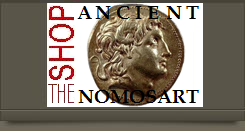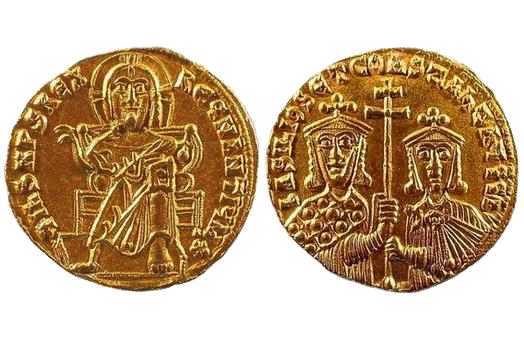
about ancient nomos
Ancient Nomos Art is a museum of galleries exhibiting ancient coins and ancient mint maps. The coin gallery displays the diverse art and history of hand-crafted ancient Greek, Roman, Byzantine, Persian and Medieval coinage. The ancient mints mapping gallery features Greek, Roman, Byzantine, Asia Minor and Medieval mint city regions and territories. Visitor's are welcome to explore, study and enjoy Ancient Nomos Art.

Byzantine, Roman – 867 AD
Basil I
From Ancient Galleries

Obverse: Christ seated on lyre-backed throne facing forward, wearing nimbus cruciger, tunic and himation, while holding the book of Gospels in left hand.
Reverse: Facing half-figures of Basil I, wearing crown and loros, and Constantine VIII wearing crown and chlamys, with the patriarchal cross between them.
LEGEND
Obv. +IhS XPS REX – REGNANTIUM* Christ facing enthroned on lyre-backed chair, wearing nimbus cruciger, tunic and himation; right hand raised in blessing and holding Book of Gospels in left hand. Rev. bASILIOS ET COnSTAnT AUGGb, Facing half-figure busts of Basil I on left, wearing crown and loros, Constantine VIII on right, wearing crown and chlamys; each holding patriarchal cross.
Basil I, “The Macedonian” was emperor for nearly two decades from 867–886 AD. Basil I is said to have proclaimed himself emperor in 867 AD after he had Michael III murdered (see Basil I miliaresion). As a skillful ruler, Basil was able to reform finances; modernize the laws of Justinian I; help protect the poorer classes; and restore relations with the church in Rome. Coinciding with his restored relations with Rome, was the earlier official reversal of the Iconoclastic condemnation of the icons, allowing Michael III to depict the bust image of Christ on coins. Basil’s reign now introduces a new image on his gold solidus coins. The coin depicts Christ Pantocrator seated alone, facing forward and enthroned on a lyre-backed chair, with nimbus cruciger encircling behind his head. This new depiction of Christ seated on a coin is actually modeled after the beautiful mosaic art work over the imperial doorway of the historic Hagia Sophia. Here we have a unique example of Byzantine coinage borrowing the imagery from another art form. Christ appears as in the mosaic with long hair, wearing the hiton tunic robe and himation mantle cloth draped over his left shoulder. His right hand is raised in blessing while his left hand supports a book of Gospels. His right leg is inclined to the left and his feet are bare with toes visible. The latin obverse legend translates, “Jesus Christ, King of those who rule.” The reverse depicts the conventional imperial portraits of Basil and his eldest son, Constantine VIII, both facing as half-figures and each holding the patriarchal cross. Basil is known to be the emperor by his greater height, left position, and by wearing the ornamented loros garment. The latin reverse legend translates, “Basil and Constantine as Augustus, Kings of the Romans.”
DOCUMENTATION
Value: Solidus. Metal: AV Gold. Weight: 4.41 grams. Mint: Constantinople. Date: 867-879 AD.
Attribution: Dumbarton Oaks Collection, 2a; Füeg 3.C.1; Sear, Byzantine Coins 1704; Berk-266.
Legend, Documentation and Attribution
